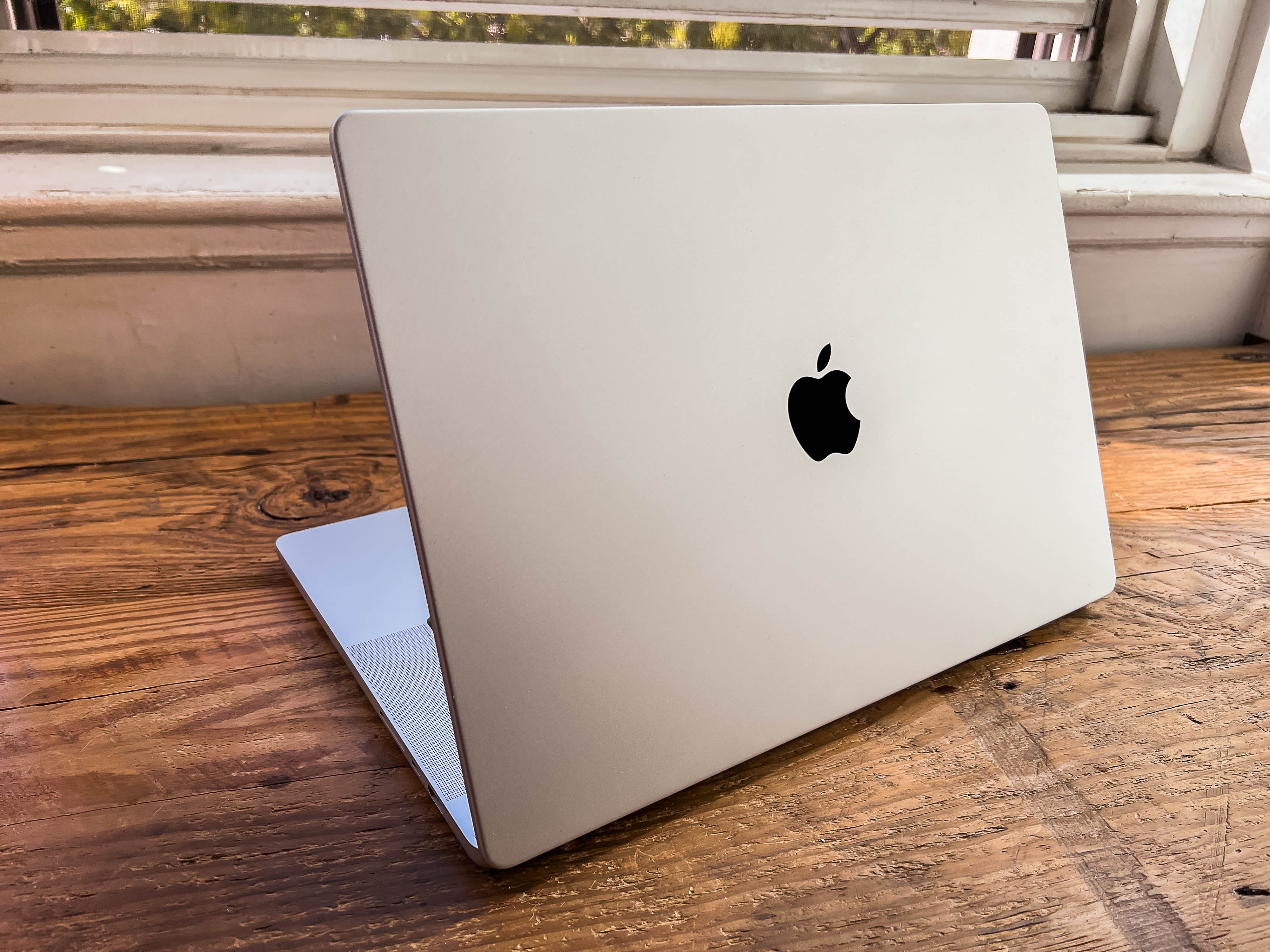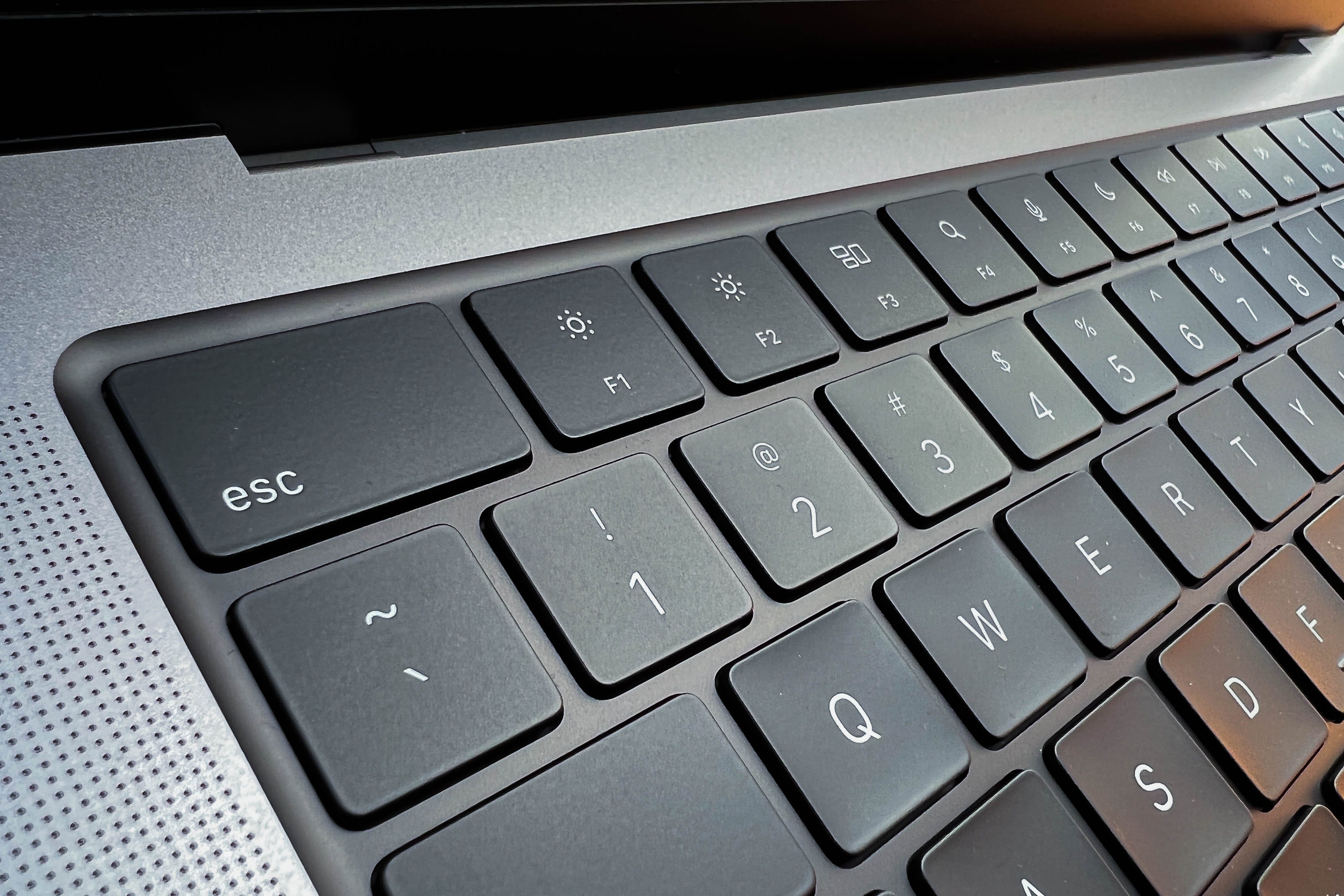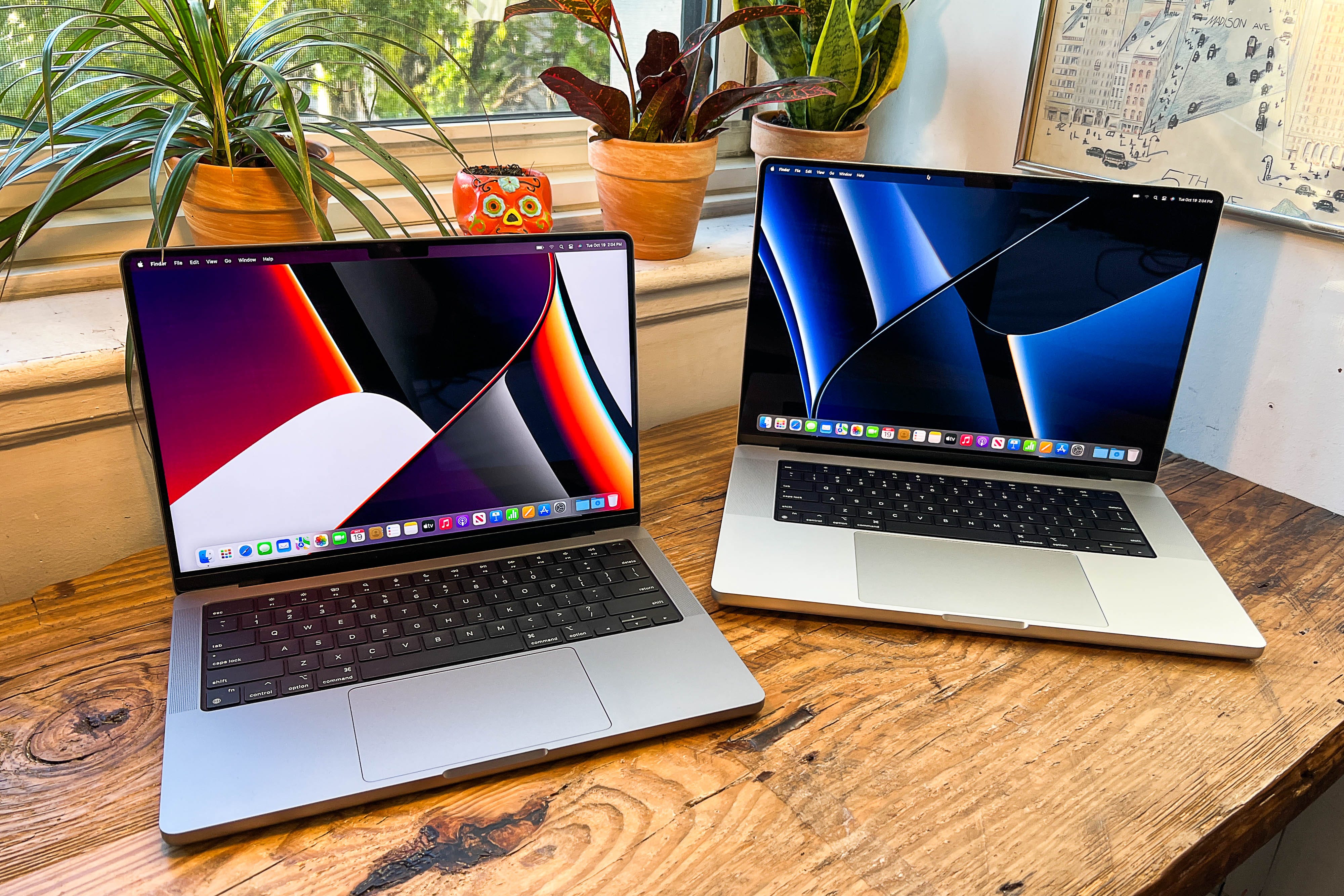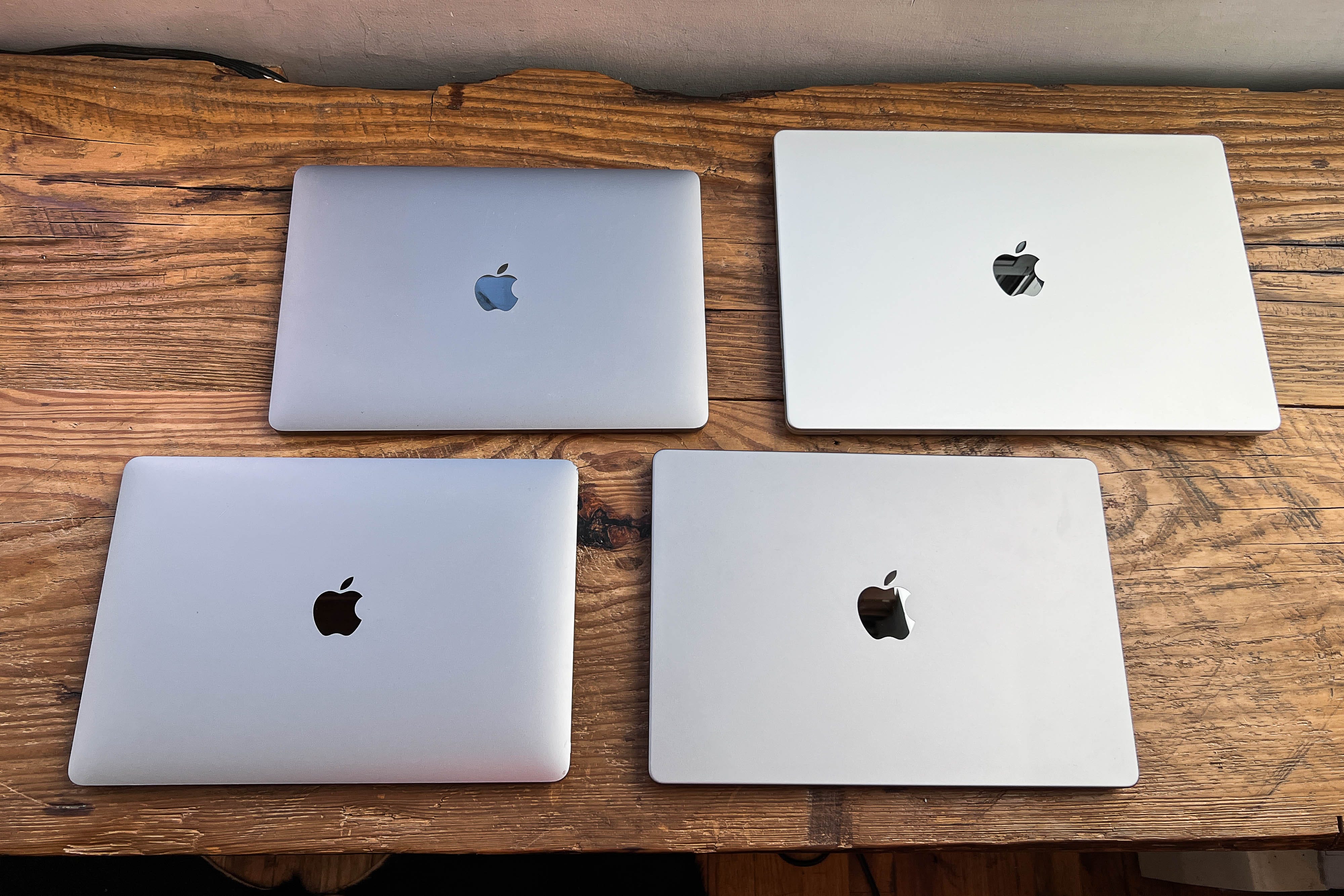A very specific audience of video editors, 3D designers and other creative professionals have been waiting for a new post-Intel, graphics-heavy Mac. Apple's two new super-powered MacBook Pro laptops are clearly aimed at that audience, with an emphasis on graphics processing and connectivity. Now, these power users will have to decide if the expensive new versions are pro enough for their needs. Our early hands-on experience so far says yes.
The 14- and 16-inch MacBook Pros are remarkably similar in design and component options. Both add the same resurrected ports, new Mini-LED display and improved webcam. Both are available with either the M1 Pro or M1 Max chip, with a few small differences in the specific CPU configurations. Both also ditch the drive towards ever-thinner designs, with a chunky, almost retro-inspired look.
Read more: Apple MacBook Pro 14-inch M1 Pro review
As the 16-inch version is the more buzz-worthy of the two new laptops, I'll focus on it here as a true desktop replacement and a worthy heir to the late, great 17-inch MacBook Pro, last seen in 2012. In a separate review of the 14-inch MacBook Pro, I break down some of the differences between the two sizes, and who the audience for each might be.
Like
- HDMI and SD card ports return
- MagSafe power connection is back
- Bigger, better, brighter screen with slimmer bezels
- New great-looking 1080p webcam
- Huge leap in graphics performance over earlier M1 systems
- Function keys replace the Touch Bar
Don't Like
- Higher-end configs quickly drive up the price
- Screen has a notch for the webcam
Big and bold
The first thing you notice about the new 16-inch MacBook Pro is its build is slightly thicker and heavier than its predecessor. And unlike some earlier MacBooks, this version doesn't try as hard to hide its size with curves and tapers. It's proudly angular, with thicker sides for more ports and chunky rubber feet on the bottom. It's also about a half-pound heavier, which ain't peanuts. It embraces an almost retro style on the outside, while offering something new on the inside.

With so many changes, I'm hard-pressed to say which side of that coin is the most important. To be sure, the new M1 Pro and M1 Max chips are precisely what a slice of the creative pro market has been waiting for. These new chips replace the need for both an Intel CPU and discrete AMD graphics, a combo previously found in only a few high-end Macs. In other words, after a long wait, professional video editors and 3D modelers have a new MacBook aimed squarely at them.
And with prices that start at $2,500 for the 16-inch model and $2,000 for the 14-inch, it's probably a good idea to have the business justification for such a hefty purchase all lined up -- even if someone else (like your employer) is paying for it.
Current MacBook lineup
| 14-inch MacBook Pro | 16-inch MacBook Pro | MacBook Air (13-inch, M1) | 13-inch MacBook Pro (M1) | |
|---|---|---|---|---|
| CPU | M1 Pro or M1 Max | M1 Pro or M1 Max | M1 | M1 |
| No. of GPU cores | 14 or 16 (M1 Pro), 24 or 32 (M1 Max) | 16 (M1Pro), 24 or 32 (M1 Max) | 7 | 8 |
| Screen size | 14.2-inch | 16.2-inch | 13.3-inch | 13.3-inch |
| Screen resolution | 3,024x1,964 pixels | 3,456x2,234 pixels | 2,560x1,600 pixels | 2,560x1,600 pixels |
| Starting storage | 512GB | 512GB | 256GB | 256GB |
| Starting RAM | 16GB | 16GB | 8GB | 8GB |
| Webcam | 1080p | 1080p | 720p | 720p |
| Networking | 802.11ax Wi-Fi 6, Bluetooth 5.0 | 802.11ax Wi-Fi 6, Bluetooth 5.0 | 802.11ax Wi-Fi 6, Bluetooth 5.0 | 802.11ax Wi-Fi 6, Bluetooth 5.0 |
| Connections | Thunderbolt USB-C x3, HDMI, SDXC card, MagSafe 3 | Thunderbolt USB-C x3, HDMI, SDXC card, MagSafe 3 | Thunderbolt USB-C x2 | Thunderbolt USB-C x2 |
| Weight | 3.5 lbs | 4.7 lbs | 2.8 lbs | 3.0 lbs |
| Starting price | $1,999 | $2,499 | $999 | $1,299 |
Playing the greatest hits
If everything comes back in style eventually, it must be time for HDMI ports and SD card slots to return. I'm as shocked as anyone by the return of not only these classic-but-useful ports, but also the long-dead MagSafe power connector.
If you've followed Apple evolution as long as I have, you know nothing is permanent when it comes to ports. (I mean, Apple would never take the headphone jack out of the iPhone, right?)
It's as if Apple designers decided to go through all the feedback they've gotten for years and cherry pick everyone's top handful of wishlist requests (with apologies to whoever wanted mini-DisplayPort or DVI to return).

I recall the very first MacBook Pro from 2006, which I reviewed as well. The original Pro cost a similar $2,800 and included three USB 2.0 ports; FireWire 400 and FireWire 800 ports; an ExpressCard slot; and a DVI port. It wasn't until the first Retina screen MacBook Pro, which I reviewed in 2012, that HDMI first made its way to a MacBook. But it disappeared a few years after that, when Apple moved toward USB-C starting with the 12-inch MacBook. The SD card slot similarly came and went over the years.
HDMI is something people have been asking to get back. It's great to be future-forward, but HDMI remains immensely useful, even if it's transitioning into being more of a legacy port. That's also why we had laptops with VGA ports for so many years after they should have vanished. People have older or legacy devices, like printers, projectors and displays, and they want to be able to plug into those immediately, with a cable common enough that you might luck out and find one buried in the back of a desk drawer. In a pinch, I can probably dig up an HDMI cable from somewhere, or steal one from a game console. You're less likely to run across a USB-C-to-HDMI dongle by sheer luck.
A look at the new 14-inch and 16-inch Apple MacBook Pro
See all photosMagnetic attraction
The MagSafe connection, a clever power plug design that stayed in place but popped away harmlessly if you tripped over it, was also phased out years ago in favor of USB-C. I loved MagSafe, and was sorry to see it go. But there was also a greater social good that came from everyone using the same kind of USB-C plug, so I was skeptical to hear it was making a comeback.
Here's my logic, which you are free to disagree with. For the past several years, if someone shouts out -- in a classroom, coffee shop or socially distanced office -- "Does anyone have a MacBook charger," everyone knows you're talking about a power brick with a USB-C cable. I could charge my Nintnedo Switch with my MacBook charger and charge my MacBook with my Nintendo Switch charger. I've used Lenovo chargers on Macs, Dell chargers on Lenovos and so on.

You can still charge this new MacBook with almost any USB-C charger, by using one of the three USB-C ports. I tried it with a 65-watt Lenovo charger, a 39-watt Switch charger and an older 61-watt MacBook charger. All worked, some much faster than others. The 16-inch Pro comes with a massive new 140-watt MagSafe 3 charger, while the 14-inch Pro has a 96-watt MagSafe 3 charger.
The MagSafe cable that starts with USB-C on one end and terminates in the MagSafe plug on the other end has a woven covering, much like the cables for the 24-inch M1 iMac. It's a much nicer feel than plain rubbery cables than last year's M1 MacBooks included.
In practice, MagSafe is just as good as I remember it; the magnetic plug end, which looks very similar to the older models, snaps right on easily and stays in place unless you give it a good tug. Microsoft also has a version of this, with a small magnetic fin that slots into a power port on Surface Pro tablets. But in that case, the magnetic head never stays seated and always routes the cable somewhere awkward, so it's good you can use regular USB-C to charge those as well.
In the end, I'm glad MagSafe is back, even though I'll have to think more about which cables I bring when I take a trip or head out to work at a local coffee shop.

How well the notch blends in depends on your desktop background color.
Dan Ackerman/CNETNotch your average laptop screen
We've hit peak screen bezel. Or maybe peak non-bezel. The border around the display here has gotten so thin that there's not even room for a webcam any longer. I've seen this happen on other laptops as well. In those cases, the camera gets moved somewhere awkward, or it's reduced to a tiny pinhole camera with poor image quality.
Here the camera gets slotted into an iPhone-like notch at the top of the display. Yes, just like an iPhone. And like the iPhone, it's annoying and too obvious at first. You can't stop seeing it cutting into your screen real estate. Then, in a few hours or days, it blends into the background and you forget about it.
The notch implementation in MacOS is especially clever, as the menu bar for whatever app you have open moves up to sit right beside the camera notch. It's much better than just having dead space there and frees up the rest of the screen for better things. As far as design compromises go, it's a pretty good one.

Shot seconds apart, the new 1080p MacBook webcam versus last year's 720p MacBook webcam.
Dan Ackerman/CNETThe camera will also spoil you quickly if you're used to the lower-res 720p cameras in other Macs (and most Windows laptops as well). In our era of nonstop web meetings and remote conferences, your webcam matters. These new laptops join the 27-inch (Intel) iMac and M1 24-inch iMac, as well as some other computers like the Surface Pro 8, in adding a full-HD camera, with 1,080 lines of horizontal resolution. Once you start using a better camera for web meetings, it's impossible to go back.
The Mini-LED display (Apple calls it a Liquid Retina XDR display) is similar to the screen in the larger iPad Pro model, and also can go up to a 120Hz refresh rate. Like the iPad Pro and other mini LED devices, the actual refresh rate is variable, which can save on battery life. It's also brighter, hitting a sustained brightness of 1,000 nits, versus 500 nits (it's a measurement of brightness, explained here) for previous models.

The border around the MacBook's screen is now much thinner, compared to last year's MacBook Pro.
Dan Ackerman/CNETIn practice, it's OLED-like, by which I mean it combines near-total blacks with extreme brightness, perfect for high dynamic range content -- not very surprising, since it's essentially the same screen technology in the company's Pro Display XDR. I'll admit, I took Apple's suggestion and opened up a 4K episode of Foundation on Apple TV Plus , and it looked great. Almost more importantly, it sounded great with excellent wide spatial separation from the six-speaker system. (However, I still have no idea what's going on in Foundation.)
The Apple Touch Bar (2016-2021)
I'm surprised the Touch Bar lasted as long as it did. The idea of a second display, especially a touch one, is a good idea on paper. Some phones and laptops are even adding secondary displays today. But in this case, it never really caught on. So with barely a mention, it's gone and been replaced with good, old-fashioned function keys.

Welcome back, Function keys!
Dan Ackerman/CNETThe best part of the Touch Bar survives beyond its official cancellation, though. The Touch ID fingerprint reader has been broken out into its own component and is found now in the MacBook Air, the Pro and the 24-inch iMac's keyboard.
I won't go as far as defending the Touch Bar, but I already miss riding the fader on brightness and volume instead of tapping the function keys over and over again.
Pro or Max?
The big question is, are these new M1 Pro and M1 Max chips powerful enough to make the MacBook Pro feel truly pro? These two chip options, both available in either screen size, have been explained in great detail by several of my colleagues.

The 14-inch and 16-inch MacBook Pro models.
Dan Ackerman/CNETAs my CPU-expert colleague Lori Grunin explains, "There are two versions of the M1 Pro, one with eight CPU cores and 14 GPU cores and one with 10 CPU cores and 16 GPU cores." The M1 Max also has 10 CPU cores, but your choice of 24 or 32 GPU cores. Lori says, "The M1 Max and M1 Pro clearly differ in terms of peak performance, with the M1 Max doubling some important contributors to theoretical performance, notably the number of hardware ProRes accelerators, which is extremely important for pro video editing." The new MacOS Monterey will also purportedly add a high-power mode, like a Windows PC's high-performance mode, for 16-inch systems with the M1 Max chip.
I've only been using these new MacBooks for a few days so far. In my first wave of testing, both the M1 Pro (in the 14-inch) and the M1 Max (in the 16-inch) scored higher on benchmark tests than either the first wave of M1 Macs or comparable Intel-powered PCs.
MacBook Pro M1 Pro and M1 Max performance
| GeekBench Multicore | Cinebench R23 multicore | |
|---|---|---|
| MacBook Pro, 14-inch, M1 Pro | 12529 | 12302 |
| MacBook Pro, 16-inch, M1 Max | 12627 | 12365 |
| MacBook Pro, 13-inch, M1 (2020) | 7457 | 7772 |
| 27-inch iMac, Intel Core i9 (2020) | 10140 | N/A |
Since video editing is such a big part of the Mac ecosystem, and a big selling point for M1 Pro and M1 Max, I tried that, too. In Adobe Premiere, I cut together a few short 8K video clips shot by one of our video producers. Then I threw a whole bunch of random things at the project -- different color correction on every clip, transitions, digital effects and floating titles. My resulting video was about 50 seconds long, and I exported it as an 8K H.264 file at a constant 50Mbps bit rate.
As shown in the chart below, the new Macs completed that task more than twice as fast as either a standard M1-powered Mac or a 2019 MacBook Pro with an Intel Core i7 CPU and AMD Radeon 5300M graphics. With this quick initial test, I didn't see much daylight between the Pro and Max versions of the chip, but I'm going to continue to test with more intense workloads and will update these charts as needed.
Premiere video export test
| Premiere 8K export | |
|---|---|
| MacBook Pro, 14-inch, M1 Pro | 10:44 |
| MacBook Pro, 16-inch, M1 Max | 10:11 |
| iMac 24-inch, M1 (2020) | 22:20 |
| MacBook Pro, 15-inch, Intel Core-i7/AMD (2019) | 20:37 |

The 2020 Air and 13-inch Pro, along with the 2021 14-inch and 16-inch Pro.
Dan Ackerman/CNETIs this for you?
That's the million-dollar question -- or at least the $2,500-and-up question. Every video editor and creative pro I've spoken to is either excited to get or has already preordered one. For that audience, the decision comes down more to screen size and a small, medium or large number of GPU cores.
If you're not specifically going to use these new hardware capabilities and just want the latest, coolest MacBook, know that you're making what is essentially a vanity purchase. The plain old $999 MacBook Air, with its own M1 Chip, is still the most universally useful laptop most people can buy. You do, however, lose out on the new 1080p webcam, which is frankly fantastic.
We will continue to update this review with additional test scores and analysis, including battery test scores (my initial video streaming battery test ran for 16.5 hours), in the coming weeks.
"Review" - Google News
October 26, 2021 at 03:53AM
https://ift.tt/3EjpoZk
Apple MacBook Pro 2021 review: M1 Max meets retro ports - CNET
"Review" - Google News
https://ift.tt/2YqLwiz
https://ift.tt/3c9nRHD
Bagikan Berita Ini














0 Response to "Apple MacBook Pro 2021 review: M1 Max meets retro ports - CNET"
Post a Comment